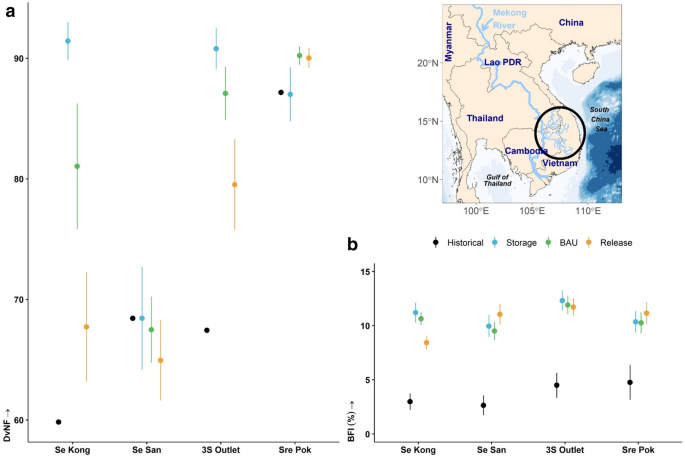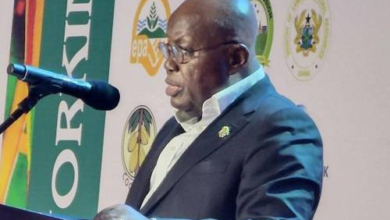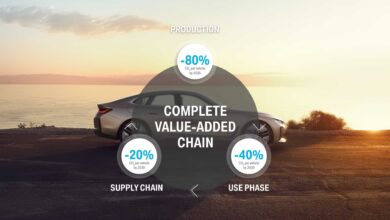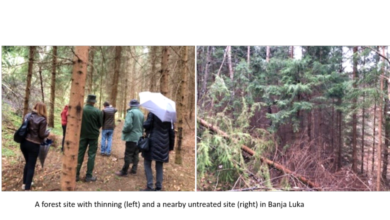Diagnosing challenges and setting priorities for sustainable water resource management under climate change

De Stefano, L., Petersen-Perlman, J. D., Sproles, E. A., Eynard, J. & Wolf, A. T. Assessment of transboundary river basins for potential hydro-political tensions. Global Environ. Chang. 45, 35–46 (2017).
Reed, P. M. & Kasprzyk, J. Water resources management: The myth, the wicked, and the future. J. Water Res. Plan. Man. 135, 411–413 (2009).
Reddy, V. R. & Syme, G. J. Social sciences and hydrology: An introduction. J. Hydrol. 518, 1–4 (2014).
Grafton, R. Q. et al. Global insights into water resources, climate change and governance. Nat. Clim. Change 3, 315–321 (2013).
UNESCO & UN-Water. United Nations World Water Development Report 2020: Water and Climate Change. Paris, France: UNESCO; 2020. Report No.: ISBN: 978-92-3-100371-4.
Ziv, G., Baran, E., Nam, S., Rodríguez-Iturbe, I. & Levin, S. A. Trading-off fish biodiversity, food security, and hydropower in the Mekong River Basin. Proc. Natl. Acad. Sci. USA 109, 5609–5614 (2012).
Roy, S. G. et al. A multiscale approach to balance trade-offs among dam infrastructure, river restoration, and cost. Proc. Natl. Acad. Sci. USA 115, 12069–12074 (2018).
Auerswald, K., Moyle, P., Seibert, S. P. & Geist, J. HESS Opinions: Socio-economic and ecological trade-offs of flood management—benefits of a transdisciplinary approach. Hydrol. Earth Syst. Sc. 23, 1035–1044 (2019).
Fung, Z., Pomun, T., Charles, K. J. & Kirchherr, J. Mapping the social impacts of small dams: The case of Thailand’s Ing River basin. Ambio 48, 180–191 (2019).
Kareiva, P. M. Dam choices: Analyses for multiple needs. Proc. Natl. Acad. Sci. USA 109, 5553–5554 (2012).
Winemiller, K. O. et al. Balancing hydropower and biodiversity in the Amazon, Congo, and Mekong. Science 351, 128–129 (2016).
Lund, J. R. Integrating social and physical sciences in water management. Water Resour. Res. 51, 5905–5918 (2015).
Wesselink, A., Kooy, M. & Warner, J. Socio-hydrology and hydrosocial analysis: toward dialogues across disciplines. WIREs Water 4, e1196 (2017).
Pahl-Wostl, C. The role of governance modes and meta-governance in the transformation towards sustainable water governance. Environ. Sci. Policy 91, 6–16 (2019).
Hadjimichael, A. et al. Defining robustness, vulnerabilities, and consequential scenarios for diverse stakeholder interests in institutionally complex river basins. Earth’s Future 8, e2020EF001503 (2020).
Mekong River Commission. Basin-Wide Assessment of Climate Change Impacts on Hydropower Production. Final Report. Vientiane, Lao PDR; 2018 September 2018.
Kang, H., Sridhar, V., Mainuddin, M. & Trung, L. D. Future rice farming threatened by drought in the Lower Mekong Basin. Sci. Rep. 11, 9383 (2021).
Darby, S. E. et al. Fluvial sediment supply to a mega-delta reduced by shifting tropical-cyclone activity. Nature 539, 276–279 (2016).
Smajgl, A. et al. Responding to rising sea levels in the Mekong Delta. Nat. Clim. Change 5, 167–174 (2015).
Gunawardana, S. K., Shrestha, S., Mohanasundaram, S., Salin, K. R. & Piman, T. Multiple drivers of hydrological alteration in the transboundary Srepok River Basin of the Lower Mekong Region. J. Environ. Manag. 278, 111524 (2021).
Wild, T. B. & Loucks, D. P. Managing flow, sediment, and hydropower regimes in the Sre Pok, Se San, and Se Kong Rivers of the Mekong basin. Water Resour. Res. 50, 5141–5157 (2014).
Kondolf, G. M. et al. Changing sediment budget of the Mekong: Cumulative threats and management strategies for a large river basin. Sci. Total Environ. 625, 114–134 (2018).
Null, S. E. et al. A meta-analysis of environmental tradeoffs of hydropower dams in the sekong, sesan, and srepok (3S) rivers of the lower mekong basin. Water 13, 63 (2021).
Shrestha, B., Cochrane, T. A., Caruso, B. S., Arias, M. E. & Piman, T. Uncertainty in flow and sediment projections due to future climate scenarios for the 3S Rivers in the Mekong Basin. J. Hydrol. 540, 1088–1104 (2016).
Shrestha, B., Cochrane, T. A., Caruso, B. S. & Arias, M. E. Land use change uncertainty impacts on streamflow and sediment projections in areas undergoing rapid development: A case study in the Mekong Basin. Land Degrad. Dev. 29, 835–848 (2018).
Lane, S. N. Acting, predicting and intervening in a socio-hydrological world. Hydrol. Earth Syst. Sci. 18, 927–952 (2014).
Sivapalan, M. & Blöschl, G. Time scale interactions and the coevolution of humans and water. Water Resour. Res. 51, 6988–7022 (2015).
Sabo, J. L. et al. Designing river flows to improve food security futures in the Lower Mekong Basin. Science 358, eaao1053 (2017).
Schmitt, R. J. P., Bizzi, S., Castelletti, A. & Kondolf, G. M. Improved trade-offs of hydropower and sand connectivity by strategic dam planning in the Mekong. Nat. Sustain. 1, 96–104 (2018).
Mohammed, I. N., Bolten, J. D., Srinivasan, R. & Lakshmi, V. Satellite observations and modeling to understand the Lower Mekong River Basin streamflow variability. J. Hydrol. 564, 559–573 (2018).
Thrasher, B., Maurer, E. P., McKellar, C. & Duffy, P. B. Technical Note: Bias correcting climate model simulated daily temperature extremes with quantile mapping. Hydrol. Earth Syst. Sci. 16, 3309–3314 (2012).
Vollmer, D. et al. Integrating the social, hydrological and ecological dimensions of freshwater health: The Freshwater Health Index. Sci. Total Environ. 627, 304–313 (2018).
Souter, N. J. et al. Using the freshwater health index to assess hydropower development scenarios in the Sesan, Srepok and Sekong River Basin. Water 12, 788 (2020).
Mekong River Commission. The Council Study: The Study on the Sustainable Management and Development of the Mekong River Basin including Impacts of Mainstream Hydropower Projects. Climate Change Report. Vientiane, Laos; 2017.
Meinshausen, M. et al. The RCP greenhouse gas concentrations and their extensions from 1765 to 2300. Clim. Change 109, 213 (2011).
Taylor, K. E., Stouffer, R. J. & Meehl, G. A. An overview of CMIP5 and the experiment design. Bull. Am. Meteorol. Soc. 93, 485–498 (2012).
Bezerra, M. O., et al. Operationalizing integrated water resource management in latin america: insights from application of the freshwater health index. Environ. Manag. (2021).
Wen, Z., Li, X. & Li, T. Comprehensive Study on Freshwater Ecosystem Health of Lancang River Basin in Xishuangbanna of China. Water 12, 1716 (2020).
Gehrke, P. C., Brown, P., Schiller, C. B., Moffatt, D. B. & Bruce, A. M. River regulation and fish communities in the Murray-Darling river system, Australia. Regul. River 11, 363–375 (1995).
Mohammed, I. N., Bolten, J., Srinivasan, R. & Lakshmi, V. Improved hydrological decision support system for the Lower Mekong River Basin using satellite-based earth observations. Remote Sens. 10, 885 (2018).
Poff, N. A hydrogeography of unregulated streams in the United States and an examination of scale-dependence in some hydrological descriptors. Freshw. Biol. 36, 71–79 (1996).
Tsang, Y., Infante, D. M., Wang, L., Krueger, D. & Wieferich, D. Conserving stream fishes with changing climate: Assessing fish responses to changes in habitat over a large region. Sci. Total Environ. 755, 142503 (2021).
Polimeni, J. M., Iorgulescu, R. I. & Chandrasekara, R. Trans-border public health vulnerability and hydroelectric projects: The case of Yali Falls Dam. Ecol. Econ. 98, 81–89 (2014).
Yun, X. et al. Can reservoir regulation mitigate future climate change induced hydrological extremes in the Lancang-Mekong River Basin?. Sci. Total Environ. 785, 147322 (2021).
Liu, X., Souter, N. J., Wang, R. Y. & Vollmer, D. Aligning the freshwater health index indicator system against the transboundary water governance framework of Southeast Asia’s Sesan, Srepok, and Sekong River Basin. Water 11, 2307 (2019).
Ha, T. P., Dieperink, C., DangTri, V. P., Otter, H. S. & Hoekstra, P. Governance conditions for adaptive freshwater management in the Vietnamese Mekong Delta. J. Hydrol. 557, 116–127 (2018).
Wesselink, A. et al. Trends in flood risk management in deltas around the world: Are we going ‘soft’?. IJWG 3, 25–46 (2015).
Soukhaphon, A., Baird, I. G. & Hogan, Z. S. The Impacts of Hydropower Dams in the Mekong River Basin: A Review. Water 13, 265 (2021).
Wan Mohtar, W. H. M. et al. Assessment of dam appurtenant structures under multiple flow discharge scenarios. Ain Shams Eng. J. 11, 913–922 (2020).
IHA. The 2020 hydropower status report: Sector trends and insights. London, United Kingdom: International Hydropower Association; 2020.
Merme, V., Ahlers, R. & Gupta, J. Private equity, public affair: Hydropower financing in the Mekong Basin. Global Environ. Chang. 24, 20–29 (2014).
Mohammed, I. N. NASAaccess: Downloading and reformatting tool for NASA earth observation data products. National Aeronautics and Space Administration, Goddard Space Flight Center, Greenbelt, Maryland, 2019. https://github.com/nasa/NASAaccess.
Mohammed, I. N. et al. Ground and satellite based observation datasets for the Lower Mekong River Basin. Data Brief 21, 2020–2027 (2018).
Arnold, J. G. et al. SWAT: model use, calibration, and validation. T ASABE 55, 1491–1508 (2012).
Wood, A. W., Leung, L. R., Sridhar, V. & Lettenmaier, D. P. Hydrologic implications of dynamical and statistical approaches to downscaling climate model outputs. Clim. Change 62, 189–216 (2004).
Wood, A. W., Maurer, E. P., Kumar, A. & Lettenmaier, D. P. Long-range experimental hydrologic forecasting for the eastern United States. J. Geophys. Res-Atmos. 107, 4429 (2002).
Maurer, E. P. & Hidalgo, H. G. Utility of daily vs. monthly large-scale climate data: An intercomparison of two statistical downscaling methods. Hydrol. Earth Syst. Sci. 12, 551–563 (2008).
Oeurng, C., Cochrane, T. A., Arias, M. E., Shrestha, B. & Piman, T. Assessment of changes in riverine nitrate in the Sesan, Srepok and Sekong tributaries of the Lower Mekong River Basin. J. Hydrol. Reg. St. 8, 95–111 (2016).
Huffman, G. J., et al. NASA Global Precipitation Measurement (GPM) Integrated Multi-satellitE Retrievals for GPM (IMERG). https://pmm.nasa.gov/sites/default/files/document_files/IMERG_ATBD_V5.2.pdf (2018).
WLE. Dataset on the dams of the Irrawaddy, Mekong, Red and Salween River Basins. CGIAR Research Program on Water Land and Ecosystems – Greater Mekong https://wle-mekong.cgiar.org/maps/ (2019).
Basist, A., Carr, A., Eyler, B., Weatherby, C. & Williams, C. Mekong Dam Monitor: An open-source online platform for near-real time monitoring of dams and environmental impacts in the Mekong Basin https://www.stimson.org/project/mekong-dam-monitor/ (2020).
The Mekong River Commission. Near Real-time Hydrometeorological Monitoring https://monitoring.mrcmekong.org/ (2020).
Food and Agriculture Organization of the United Nations. AQUASTAT – FAO’s Global Information System on Water and Agriculture http://www.fao.org/aquastat/en/databases/dams (2015).
Poff, N. L. et al. The natural flow regime. Bioscience 47, 769–784 (1997).
Bunn, S. E. & Arthington, A. H. Basic principles and ecological consequences of altered flow regimes for aquatic biodiversity. Environ. Manag. 30, 492–507 (2002).



